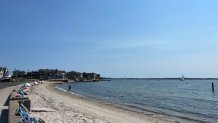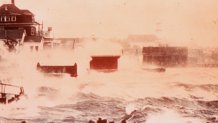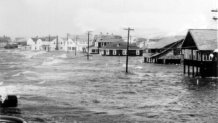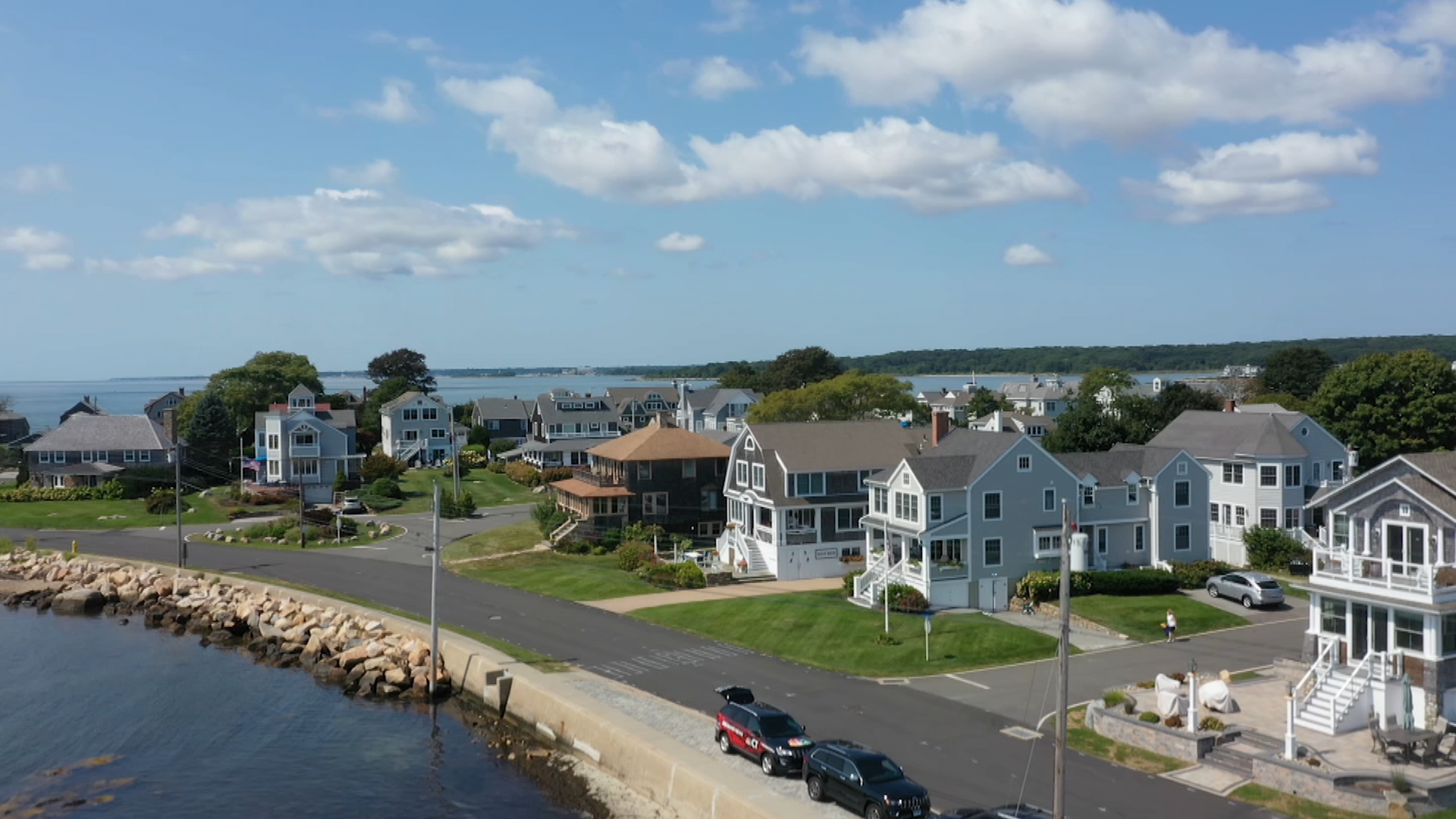Hurricane Sandy formed like most October hurricanes in the Caribbean on Oct. 22, 2012.
The storm splintered homes, flooded neighborhoods and toppled trees across the state. Sandy raced north through the Atlantic and took a hard left turn into New Jersey - an exceptionally rare track for an exception storm.
New York and New Jersey took a direct hit from the storm, with scenes of devastation stretching from the Jersey Shore to New York City. Here in Connecticut, Sandy struck at low tide, but the damage on the shoreline was still substantial.
Even though Sandy was no longer a hurricane at landfall, the storm crashed ashore with unrelenting fury.
A storm surge of up to 10 feet poured inland from Long Island Sound, flooding neighborhoods and swallowing entire homes in the process. Some people's lives were changed in a matter of minutes.
Farther inland, the wind caused the most damage. Up to 80 mph wind gusts splintered trees and caused power outages lasting nearly a week.
On the Guilford Green, Sandy left a tangled mess of trees and roots. In Easton, a falling tree killed an on-duty firefighter who was helping to clear debris during the storm.
Photos: A Look Back on Hurricane Sandy's Impact on Connecticut
Nationally, 157 people died, including four in Connecticut. Sandy did $82 billion in damage, making it the fifth costliest U.S. hurricane on record.
Now, a decade later, we spoke with people who lived through Sandy and delved into how towns are preparing for the next storm that hits.
Old Saybrook: Looking Back on the Devastating Damage
One of the towns hardest hit by Sandy was Old Saybrook. The storm flooded neighborhoods, battered shoreline homes and sparked a large fire in Chalker Beach.
NBC Connecticut's Ryan Hanrahan spoke with a few shoreline residents who saw Sandy's fury up close.
Winds of 80 mph reached Old Saybrook during Hurricane Sandy. The whipping wind tore down trees while Sandy's storm surge devastated some parts of town.
JT Dunn was the Old Saybrook fire chief at the time and he said as the night grew and the tide came up, firefighters conducted a lot of water rescues and helped people trapped in their homes.
With feet of water flooding parts of town, a call about a large fire burning on Chalker Beach came in late at night. It burned for hours.
“I knew water was going to be an issue and I really didn’t need to risk our firefighters' lives unnecessarily to battle a fire that was in the middle of Long Island Sound. These homes were surrounded by water," Dunn said.
Hank Kuharski lived just a few streets over from where the fire broke out. He decided to ride out the storm.
“And then the waves started to come in. I was on my second floor on my deck and I could see the waves," Kuharski said. "It was nerve-wracking."
His house was spared, but others weren't so lucky.
Valerie Aloiso wasn't home when Sandy struck, but she remembers hurrying back to make sure her family was okay.
“Thankfully we didn’t have as bad of damage as some of the homes that were lost, but you know the porch was kind of blown off and we had four or five feet of water in the house and had to do what we had to do. Repair everything," Aloiso said.
Other homes needed to be rebuilt completely.
Sandy showed us that communities like Chalker Beach and so many others along the Connecticut shoreline are vulnerable to hurricanes and storm surge flooding. But for many people who live along Long Island Sound, the risk of another hurricane is a risk they're willing to take.
Groton: Preparing for the Next Big Storm
A storm like Sandy is a stark reminder of how vulnerable Connecticut is to hurricanes.
Meteorologist Josh Cingranelli visited Groton, where they're preparing for the next storm using some of the lessons learned from Sandy.
Hurricane Sandy's destruction along coastal Connecticut resulted in cities and towns deciding to analyze what can be done to help mitigate storm damage going forward.
We looked at what has changed in the last 10 years with climate adaptations, and how cities and towns are adapting to the changing climate.

"There's a great deal of work that needs to be done. I think our emergency management plans for dealing with the aftermath are in pretty good shape. But for proactive planning to try to mitigate those impacts, there is a lot to do," Jessie Stratton, a board member for the Town of Groton Resiliency and Sustainability Task Force, said.
Stratton said one of the areas that need to be focused on is zoning and code regulations. If a structure is taken down in an area that is susceptible to flooding, should they be able to rebuild at that same location?
Mayor Keith Hedrick in the City of Groton remembers Sandy all too well. He recalls not being able to see the roads or sidewalks on Beach Pond Road as water and sand came ashore.
The mayor said climate change is something his team has been focused on over the last several years
"The intensity, the number and the duration of the storms are increasing, so when we talk about resiliency in the city there’s two things we talk about, one is the ability to recover from one storm and get ready for the next and then two is the sea level change is predicted to go up 20 inches in the next 30 years," Hedrick said.
"If there's a hurricane or any type of intensified storm event we are going to look at the built environment and how we protect property and limit the amount of damage caused," Economic Development Management for the City of Groton Cierra Patrick said.
While Sandy created a ton of destruction, it wasn't even close to being one of the strongest storms and the possibility of a much stronger storm is what is most concerning.
It's been 35 years since a landfalling hurricane has impacted Connecticut.
One of the worst hurricanes to hit Connecticut was Hurricane Carol in 1954 - it had the Town of Groton under water.

Stratton remembers it all too well.
“It surrounded our house with water and we were significantly above sea level," Stratton said. "I mean, it was it was serious, serious flooding."

While Sandy was a deadly and destructive storm, it wasn't a hurricane when it hit Connecticut.
A storm like Hurricane Carol in 1954, or even worse the Hurricane of 1938, would cause significantly more damage and likely change the coastal landscape as we know it today.
As the next big storm sets its eyes on Connecticut, coastal communities are starting to become better prepared to handle Mother Nature's wrath.
Hurricane Sandy's Biggest Impact: New York and New Jersey
Heading south to New York and New Jersey - the two states that suffered the worst from Sandy.
As bad as the storm was in Connecticut, New York and New Jersey bore the brunt of it at close to high tide. The result was catastrophic.
New York City
It was historic damage - Sandy caused more than $80 billion in repairs as the hurricane's storm surge poured into Manhattan while residents of Queens and Staten Island tried to survive a wall of water that was over 10 feet deep.
It was like the tsunami movies. The water moved in within minutes. I tried to get to my car, but the wheels were already covered.
-Arthur Elliot - Queens, New York
Sandy's record storm surge drove the Atlantic Ocean into the Rockaways in Queens, flooding hundreds upon hundreds of homes.
In the Breezy Point neighborhood of Queens, fire burned through an entire flooded neighborhood. The flames destroyed 111 homes and left behind blocks and blocks of smoking, charred rubble in its path.
The runways at LaGuardia Airport were underwater as Long Island Sound flooded the tarmac.
The Franklin D. Roosevelt East River Drive looked like a raging river as water surged over its banks. Manhattan was plunged into darkness below 39th Street after huge transformer explosions lit up the night sky.
The subway system across New York filled up with water as the East River, the Hudson and New York Harbor reached levels few could ever imagine.
In Staten Island alone, 21 people died - most from flooding. Sandy killed a total of 44 New York City residents.
As Sandy moved inland, the water receded and the true scope of the damage became clear. At some point, nearly one-fifth of New York City experienced flooding.
More than 69,000 residential units were damaged across the five boroughs.
New Jersey
The eye of Sandy tracked over Atlantic City with some of the worst damage occurring on the Jersey Shore.
Storm surge flooding devastated many popular beach towns and a decade later, some towns are still trying to recover. NBC New York's Ted Greenberg explains how much of Jersey Shore is still picking up the pieces.
"The boardwalk was all up. Buildings were shattered, windows were broken," Seaside Heights Mayor Tony Vaz told WNBC.
When Hurricane Sandy slammed the Jersey Shore, Ortley Beach was ground zero.
"I would say it looked closest to a warzone," homeowner Paul Jeffrey told WNBC. "I thought my wife was going to pass out. Everything was gone."
A massive storm surge decimated the boardwalk, businesses and homes, and some were completely washed away.
"We were all in tears. 99% of the houses and structures in Ortley Beach were damaged in that storm," Jeffrey said. "You're reminded every day wherever you go of people still trying to recover."
While much of Ortley Beach has been rebuilt, including the boardwalk, most of the small bungalows that made up this coastal community before Sandy have been replaced by much larger and much more expensive homes.
"It isn't the Ortley Beach it was before. Many, many people were simply pushed out because they could not afford to recover," Jeffrey said.
In some spots, the progress has been painfully slow. Seaside Heights, next to Ortley Beach, also wasn't spared Sandy's wrath.
"In my wildest dreams, I never saw anything like the devastation that I saw that day," Vaz said.
Sandy triggered a wave of new construction in the area. Jersey Shore towns were forced to move forward and learn from the lessons left in Sandy's wake.
"If one good thing came out of this storm, it gave us a future vision where we planned ahead, not only for growth and change of image, but also for preparation for the future if this ever happened [again]."
Sign up for our Breaking newsletter to get the most urgent news stories in your inbox.

